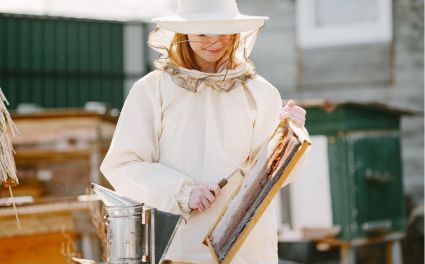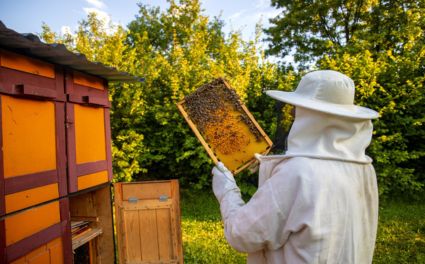Have you ever wondered about the process of capturing a swarm of bees? Imagine seeing a swarm hanging from a tree branch - it's a natural spectacle that sparks curiosity. But how do beekeepers turn this captivating event into a controlled and purposeful act?
This blog post reveals the art and science behind this beekeeping feat. We will cover everything from understanding swarm behavior to the strategic placement of traps, essential equipment, the delicate process of capturing, and the post-catching care required to ensure the seamless integration and prosperity of the captured colony. Join us on a journey into the world of beekeeping, where the buzz of swarms becomes an opportunity for responsible stewardship.
Understanding Swarm Behavior
Reasons for Swarming: Honeybee colonies naturally exhibit swarming behavior. The main reasons for this are overpopulation, hive congestion, or the arrival of a new queen. When a colony becomes overcrowded, bees form a swarm to reproduce. Some bees leave the hive to create a new one.
Signs of an Impending Swarm: Beekeepers can predict swarming by watching for certain signs. Signs of a queen cell, more drones flying, and more foragers leaving the hive are indicators to look out for. When a swarm is getting ready, the colony will focus on raising new queens.
Recognizing a Swarm in Progress: A swarm is a group of bees flying together, often making a buzzing sound. During a swarm, bees gather together in a cluster, usually on a branch or another nearby object. Beekeepers can quickly respond to these signs by capturing the swarm, which helps protect the original colony and the surrounding area.
Essential Equipment and Preparations
Protective Gear for Beekeepers: Keeping beekeepers safe is vital. A complete beekeeping suit includes a suit with a veil, gloves, and boots to protect against bee stings. This gear provides a protective barrier for beekeepers, allowing them to work confidently and without the risk of getting stung.
Necessary Tools (Hive Box, Frames, etc.): Essential tools for beekeeping include a hive tool, which helps with frame manipulation, a bee brush for handling bees gently, and a spray bottle filled with sugar water to calm the bees. The main equipment needed is the hive box or swarm trap, which should have frames for support. These tools help with capturing, transporting, and managing the swarm effectively. You can also use a swarm lure attractant.
Choosing a Suitable Location for the Swarm Trap: It is important to place the swarm trap strategically. Please think about places that are easy to reach and provide a high level of safety. Swarms are drawn to elevated positions such as trees or platforms because they resemble natural hive locations. Place the trap in a shaded area to avoid overheating. Choosing a location with fewer people around can help avoid disruptions and increase the likelihood of successfully capturing the swarm. Properly preparing your equipment and selecting the right location are important for successfully catching swarms.
Building or Setting Up a Swarm Trap
Design Considerations for Swarm Traps: The design of a swarm trap is crucial for its success. It should have the same qualities as a desirable hive. Swarm traps are wooden boxes with frames that mimic potential nesting sites for bees. Having good ventilation and entrances that look like those of a real beehive make them more attractive. You can attract scouting bees by adding a scent-catching material, like an old comb or propolis, to the interior surfaces.
Attractants and Lures: It is essential to choose the right attractants. Beekeepers commonly use lemongrass oil to attract bees to their hives. To attract scout bees, you can place a small amount of this attractant inside the swarm trap. You can create an attractive environment for a swarm by combining lemongrass oil with other attractants such as old comb or beeswax.
Proper Placement of Swarm Traps: The location of swarm traps can make a big difference in their success. To increase the chances of attracting swarms, you should place the traps at a height of between 10-20 feet, mimicking the natural locations of hives. Trees, poles, or platforms are all good options. It's best to have the entrance facing south or east to maximize morning warmth while keeping the traps in shaded areas can prevent overheating. It's also important to avoid dense vegetation to reduce the risk of entanglement. Properly securing the swarm trap and checking local regulations are essential for effective swarm trapping. By carefully considering design, attractants, and placement, beekeepers can increase their chances of successfully capturing swarms.
Monitoring and Maintenance
Regular Checks on Swarm Traps: Regularly checking swarm traps is crucial for achieving success. Beekeepers should conduct regular checks, ideally every 7 to 10 days, during swarm season. These checks help assess trap conditions and determine if there is any potential swarm activity. This regular inspection makes sure that any swarms that are caught are dealt with quickly.
Addressing Potential Issues: Vigilance is key in addressing issues that may arise. Inspect the swarm trap for any signs of damage, such as wear and tear from weather conditions or interference from other animals. To keep the trap appealing to swarming bees, make sure to fix or replace any damaged parts quickly. Also, make sure to watch out for any signs of pests or diseases that could harm the trapped swarm.
Providing Food and Water Sources: A properly set-up swarm trap takes into account the immediate requirements of the captured swarm. Make sure there is food nearby, like blooming flowers, to help the newly captured bees find food. Having a nearby water source is important for keeping the swarm hydrated. Supplying these necessary resources improves the overall health and establishment of the group in their new habitat. Monitoring and addressing these factors are important for the success of swarm-catching and the well-being of the captured colony.
Catching and Transferring the Swarm
Approaching the Swarm: Approaching a swarm requires a calm and deliberate approach. Swarming bees are usually calm and focused on protecting their queen and building a new hive. Approach the swarm slowly and avoid making sudden movements or loud noises. Assess the size and behavior of the swarm to determine the best strategy for capture.
Gently Capturing the Swarm: To capture a swarm, use a swarm-catching tool or a container placed beneath the cluster. By gently shaking or lightly brushing, the bees will usually fall into the container. You can also use a vacuum specifically made for capturing swarms, which will help minimize any disturbance to the bees. Please be careful to avoid causing harm to the queen or disturbing the fragile group.
Transferring the Swarm to a Hive Box: After capturing the swarm, move it into a hive box that has been prepared. The box needs to have frames with a comb or foundation to give the bees a structure to build on. If using a swarm trap, carefully remove the frames and relocate them to a hive box at the desired apiary location. Beekeepers can help swarms settle into their new hives more successfully by staying calm and composed during this important time. This promotes the well-being and success of the bees in their new home.
Post-Catching Care
Integration into an Existing Colony: When a swarm is meant to join an existing colony, it is important to have a gradual integration process. To introduce the captured swarm to the established hive, you can place them nearby for a few days. This helps the bees get used to the smell and behavior of the current colony. After this time, merge the two groups with caution to minimize any disturbance or conflict.
Monitoring the Health and Development of the Swarm: Regular monitoring of the captured swarm is vital in the initial stages. Monitor their search for food, the growth of young bees, and the overall condition of the hive. Check for signs of disease or stress and promptly address any problems that arise. Assessing the laying pattern of the queen and the bees' overall behavior provides valuable insights into their well-being.
Ensuring a Successful Transition: Providing a stable environment with adequate food sources and a water supply ensures the swarm's successful transition. Providing extra food, especially in the first few weeks, helps them get established. Beekeepers should stay alert to any difficulties and provide help when necessary. Beekeepers play an important role in helping swarms of bees settle into their new home by carefully managing the post-catching phase. This helps the colony grow and become productive in its new habitat.
Final Thoughts
In conclusion, mastering the art of catching a swarm transforms a natural phenomenon into a harmonious partnership between beekeepers and their buzzing charges. This guide explains various techniques for setting traps and transferring swarms, emphasizing the need for vigilance and caution. When swarms are smoothly added to hives, beekeepers see the colonies grow and thrive. The captured magic of a swarm showcases the beautiful harmony between nature and human care. Beekeepers help sustain their apiaries and strengthen the relationship between bees and beekeepers through successful captures. This enhances their understanding and connection to the intricate world of beekeeping.


